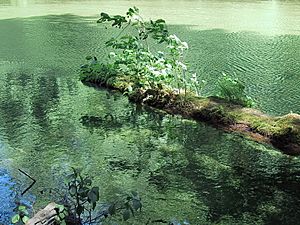Phototroph facts for kids
Phototrophs are amazing living things that can make their own food using light! The word "phototroph" comes from two Greek words: "photo" meaning light, and "troph" meaning nutrition or food. So, they are "light-eaters" in a way! Most phototrophs use sunlight to create the energy they need to live and grow.
Contents
How Phototrophs Make Their Own Food
Phototrophs are like tiny chefs that use a special process called photosynthesis. This process happens inside tiny parts of their cells called plastids. Think of plastids as mini-factories!
The Photosynthesis Recipe
For photosynthesis, phototrophs need a few simple ingredients:
- Sunlight: This provides the energy.
- Carbon dioxide: A gas from the air.
- Water: Absorbed from the ground or environment.
Inside their plastids, with the help of sunlight, they mix carbon dioxide and water. This amazing process turns these simple ingredients into sugar. This sugar is like food for the phototroph. It gives them energy and helps them grow.
What Happens to the Sugar?
Once the sugar is made, the phototroph can use it in different ways. It can be changed into other important organic molecules. These molecules are used for all the different jobs inside the phototroph's cells. For example, they use these molecules for respiration, which is how they get energy from their food to do things like grow or move.
Why Phototrophs Are So Important
Phototrophs are super important for almost all life on Earth!
- Food for Others: They are the base of most food chains. Animals that eat plants (like deer or rabbits) get their energy from phototrophs. And then, animals that eat those plant-eaters also depend on the phototrophs indirectly.
- Oxygen Producers: As a bonus, when phototrophs do photosynthesis, they release oxygen into the air. This is the oxygen that we and many other living things breathe to survive!
Who Are the Phototrophs?
The most common phototrophs you probably know are plants. But there are many others too!
- Plants: All kinds of plants, from tiny mosses to giant trees, are phototrophs.
- Algae: These are simple plant-like organisms that live in water. They can be tiny, single-celled, or large, like seaweed.
- Some Bacteria: There are also special types of bacteria that can do photosynthesis. These are called cyanobacteria, and they were some of the first phototrophs on Earth!
Images for kids
See also
 In Spanish: Fotoautótrofo para niños
In Spanish: Fotoautótrofo para niños



